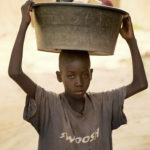 Since slavery was officially abolished, people are still loath to admit that devious and underhanded types of slavery of men, women and children may exist in the world. Nevertheless, it is also sad that seemingly millions are still suffering under a hidden modern form of slavery.
Since slavery was officially abolished, people are still loath to admit that devious and underhanded types of slavery of men, women and children may exist in the world. Nevertheless, it is also sad that seemingly millions are still suffering under a hidden modern form of slavery.
In most parts of the world and specifically in Haiti (the focus of our article), certain practices in terms of servitude in children -who are the most vulnerable- are similar to the concept of “slaves as objects” that existed hundreds of years ago. Frequently known as “restaveks”, these children are sent by their parents to live with families who employ them as domestic workers, responsible for doing everything for no pay and living in dire conditions.
This article aims to finally unveil this masked form of modern slavery that can be described as the worst form of child labour and to expose all of these exploitative practices in Haitian society, that are harmful to a child’s development and personal fulfilment.
The “restavek” phenomenon in Haiti: Solidarity turning into servitude
The term “restavek” in the Creole language literally means “reste avec” in French (“stay with” in English), and is a firmly rooted ancient Haitian tradition, intended to help the children of extremely poor families. Generally speaking, these are parents languishing in misery (usually in rural areas), who decide to entrust their children to wealthier families so as to offer them a better future by providing them with an education in exchange for menial chores. 
However, the reality which masks this child exchange today could not be further from the truth. Whilst the respective parents live under the illusion that their children are being educated, well-kept and have brighter prospects for the future than they would have had in their rural homes, they could not have imagined that in reality they have exchanged their children’s safe life for the life of a “restavek”.
Generally, these “restavek” children are prevented from going to school, are employed as domestic workers in the house, overloaded with chores and are victims of physical and verbal abuse. To be more specific, these children are awake at 4 or 5am, and they go back to sleep late at night in their makeshift bed, which is usually located under the kitchen table. At age 5, 8 or 10 years old, they have spent all day sweeping up, cleaning and polishing the house, they have taken the children to school, fetched wood, coal and water, have done the shopping and prepared the meals. Having barely eaten, they have been whipped, abused and humiliated throughout the day.
Trapped and being unable to contact their parents, they are beaten and bullied whenever they show their desire to return home to their rural families.
There are currently between 150 and 500 thousand “restavek” children, the majority of whom are girls who are particularly vulnerable to sexual abuse and rape.
The “restavek” phenomenon in Haiti: One of the worst forms of child labour that persists despite the existence of national and international laws
 In Haiti, there are numerous national and international legal provisions against exploitation and child labour. However, these provisions remain dead letters in light of the increasing number of “restavek” children.
In Haiti, there are numerous national and international legal provisions against exploitation and child labour. However, these provisions remain dead letters in light of the increasing number of “restavek” children.
Haiti has in fact ratified without reservation the Convention regarding the rights of the child, which stipulates in several of its provisions the prohibition of economic exploitation, of any dangerous work that may harm the child’s education and development, and the right to be protected against any sexual abuse, as well as protection against trafficking (Articles 32, 34 and 35).
Furthermore, Haiti ratified the ILO Convention No. 182 on the Worst Forms of Child Labour on July 19th 2007, which explicitly defines in Article 3 the worst forms of child labour including all forms of slavery where “the trafficking of children, debt bondage and serfdom and forced or compulsory labour which, by its nature or the circumstances in which it is carried out, is likely to harm the health, safety or morals of children”.
This does not even take into consideration the national laws, such as Haiti’s Constitution of 1987, which guarantees free and compulsory education for all children and the Haitian Employment Code which regulates working conditions, the minimum working age for children and sanctions for violation of children’s rights.
Taking action for “restavek” children in Haiti and all over the world
They are known as “restaveks” in Haiti, but this phenomenon can be found all over the world and particularly in Africa, where thousands of children are in servi tude for urban families.
tude for urban families.
Parents languishing under the weight of poverty and wanting to secure their children’s future make the mistake of entrusting them to relatives living in cities in the hope of seeing them educated and fulfilled. They do not doubt for even a second what their children are suffering in a faraway city.
Generally abused, mistreated and humiliated constantly, these voiceless children suffer slavery in a vicious circle, forever waiting to be freed.
It is far from our intention to change or criticise deeply rooted traditions, which in some respects have had positive effects in the past, but we merely wish to expose this practice which is turning into modern slavery and the trafficking of children.
 Despite the efforts of the Haitian government and numerous international organisations to put an end to the “restavek” child phenomenon, there is still much to achieve.
Despite the efforts of the Haitian government and numerous international organisations to put an end to the “restavek” child phenomenon, there is still much to achieve.
A more pragmatic approach to awareness and sanctioning measures could be a welcome solution.
Written by: Diane BE Translated by: Sarah Cutts Proofread by: Joséphine Dodd |
http://www.ilo.org/public/french/comp/child/download/pdf/esclavage.pdf
http://www.unicef.org/french/protection/haiti_61518.html
http://www.ohchr.org/fr/professionalinterest/pages/crc.aspx
http://www.rfi.fr/emission/20130923-haiti-le-travail-enfants-restavek
https://www.bu.edu/law/files/2015/08/frenchcurriculahaitian.pdf

